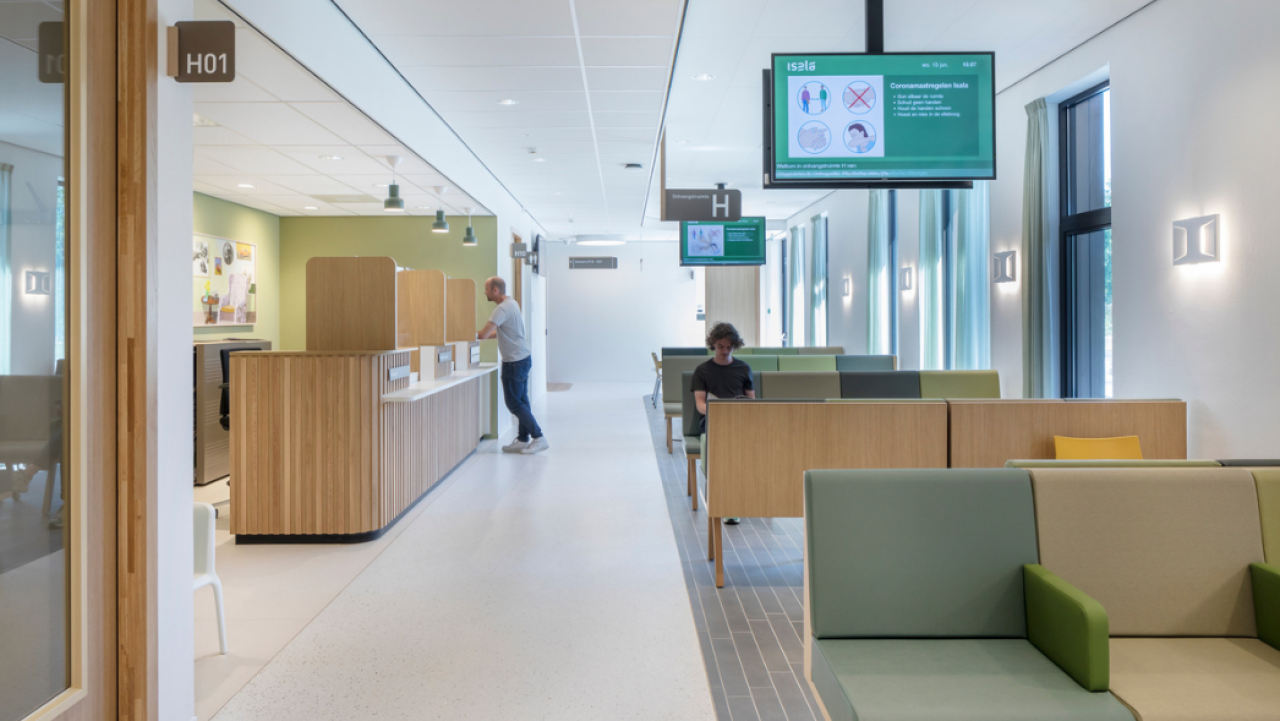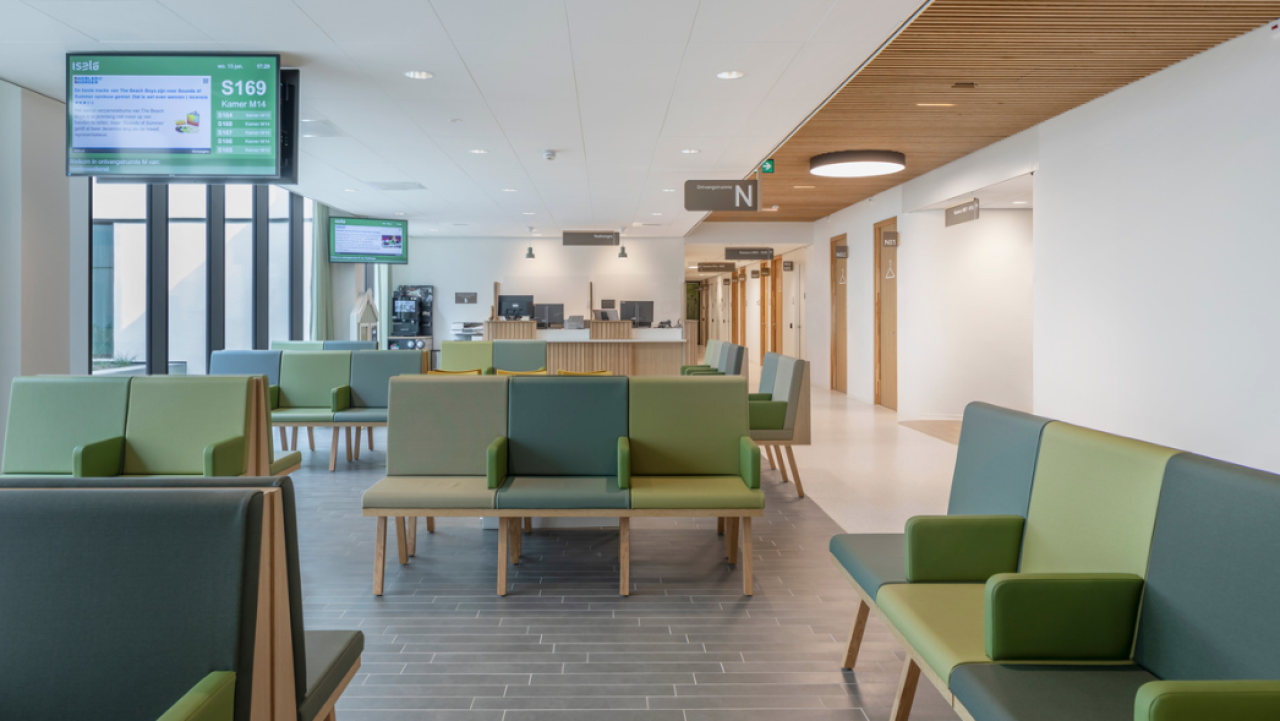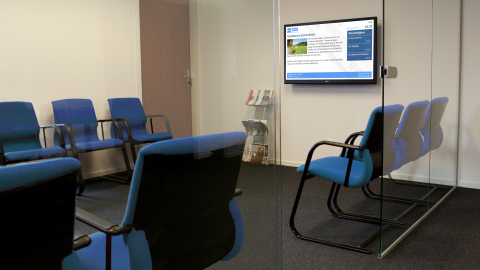Isala Hospital
Hospital uses digital signage as a full-fledged communication channel
Isala is a hospital with locations in Zwolle, Meppel, Steenwijk, Kampen, and Heerde. At Isala, quality of care and personal involvement are paramount. Clear and optimal communication to patients, as well as to its own employees, helps maintain the highest possible quality of care and the highest level of engagement. Isala sees digital signage, or communication via screens, as an important communication channel to reach patients and employees. Therefore, during the construction of the new Meppel location, early consideration was given to the placement and connection of digital signage screens. Together with our partner HQ Healthcare, we provided the hospital with Wachtkamerschermen®.
Digital signage is a given
Jessica Janse, project manager at the Information & ICT department of Isala, explains: "It was immediately clear that the new construction in Meppel would be equipped with digital signage screens. Nowadays, patients see information screens as a given and it is particularly noticeable if there are no screens. That is why we took this project very seriously and carefully considered the most ideal locations for the screens. Are the screens clearly visible? Is the sun shining directly on the screens? From what distance is the text readable? And so on. By being involved early in the construction drawings, we could already account for all connections such as power and network."
Good preparation is half the battle
At Isala, they are convinced that good preparation is half the battle. In addition to thinking about the locations of the screens, early consideration was also given to the goals of the digital signage screens. An initial distinction was made between screens for patients and employees, as communication to these target groups differs.
Jessica Janse explains that the screens in the nursing departments are mainly used to display announcements and information to patients and visitors. The screens in the outpatient clinics are used for multiple purposes: "First of all, we want to confirm to patients that they are in the right place. We do this by displaying a message in the footer with 'Welcome to the reception area of ....' In another section of the screen, hospital-wide messages are displayed to inform patients and increase engagement. This includes messages about the hospital's facilities, how Isala maintains the highest possible quality of care, but also messages requesting patient cooperation."
Queue management by ChipSoft integrated
In addition, it was already known early on that a large portion of the screens in the outpatient clinics would be used for ChipSoft's queue management. However, it was known in advance that this integration would not be available at the time of the new construction’s completion. Therefore, the layout and setup of the screens already considered future queue management. This section was temporarily filled as a 'wait softener' by displaying regional news, the weather forecast, and interesting facts about the new construction.
“We received guidance from Wachtkamerschermen® in the form of so-called content sessions. During these sessions, we received advice and assistance in setting up the screens and the management environment. These were useful and pleasant sessions. Wachtkamerschermen® also helped us by designing a screen layout that optimally displays ChipSoft's queue management. Additionally, Wachtkamerschermen® created a custom message template to display our messages entirely in our house style. We only need to enter the text and image, and the system takes care of the rest," says Jessica.
Internal communication increases employee engagement
In addition to screens for patients and visitors, there are also screens for Isala employees. These screens are used for internal communication with the primary goal of increasing engagement. There is a distinction between screens in high-traffic locations and in staff rooms. In a high-traffic location, such as the clothing distribution area or a pantry, employees briefly look at the screen. Only Isala-wide staff information is shown on these screens. Jessica explains: "This includes messages from our staff association, announcements to employees, or a call for the annual flu vaccination."
The screens in staff rooms, such as a break room, are used as a digital newsletter. Jessica describes it as follows: "These screens are viewed for a longer period, and therefore, these are screens for and by the employees. For example, birthdays and anniversaries are displayed, or new employees are introduced. This increases the engagement among colleagues and promotes a pleasant working atmosphere." Jessica does note that careful consideration is given to who sees the screens. Sometimes a staff room is temporarily used to have a personal conversation with a patient and/or their family: "In that case, it is not very convenient if birthdays or staff news are being displayed. Therefore, we keep the screens in those rooms a bit more general."
Digital signage as a full-fledged communication channel
Finally, we asked Jessica if she had any tips for organizations also considering using digital signage as a communication channel: "Of course, you need to think in advance about where the screens will be placed and what will be shown on the screens. But you also need to make good arrangements about the maintenance of the broadcasts and the procedure in case of malfunctions. Who is responsible for the content of the playlists? How can employees report a malfunction? Which department takes action in case of a malfunction? And so on. If you have all that in order, you can truly use digital signage as a full-fledged communication channel, and it will actually contribute to the optimization of communication!"
This project is an example of fine cooperation between Wachtkamerschermen®, HQ Healthcare, Chipsoft and Isala Hospital. By joining forces, a suitable solution has been realised that contributes to an increase in efficiency and quality of care.
Photo's: Melanie Samat

 English
English  Nederlands
Nederlands 


